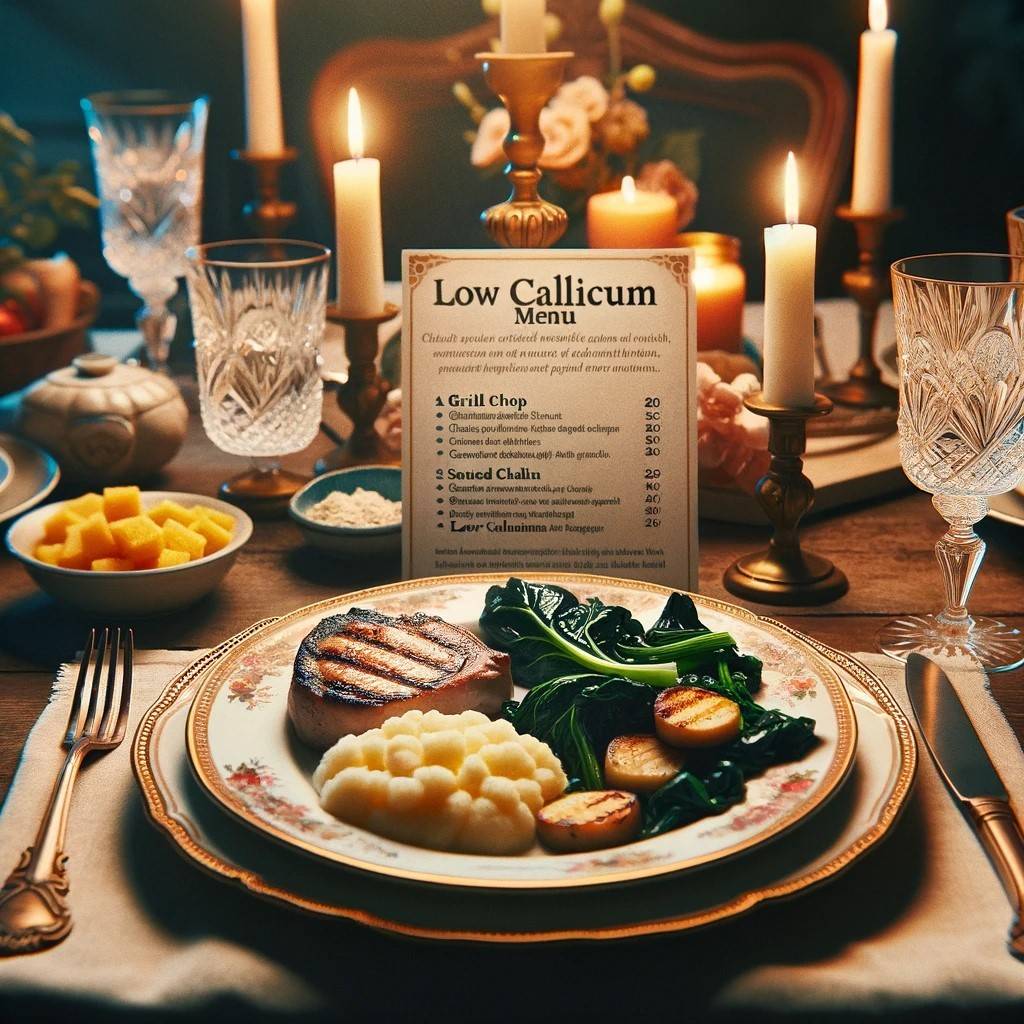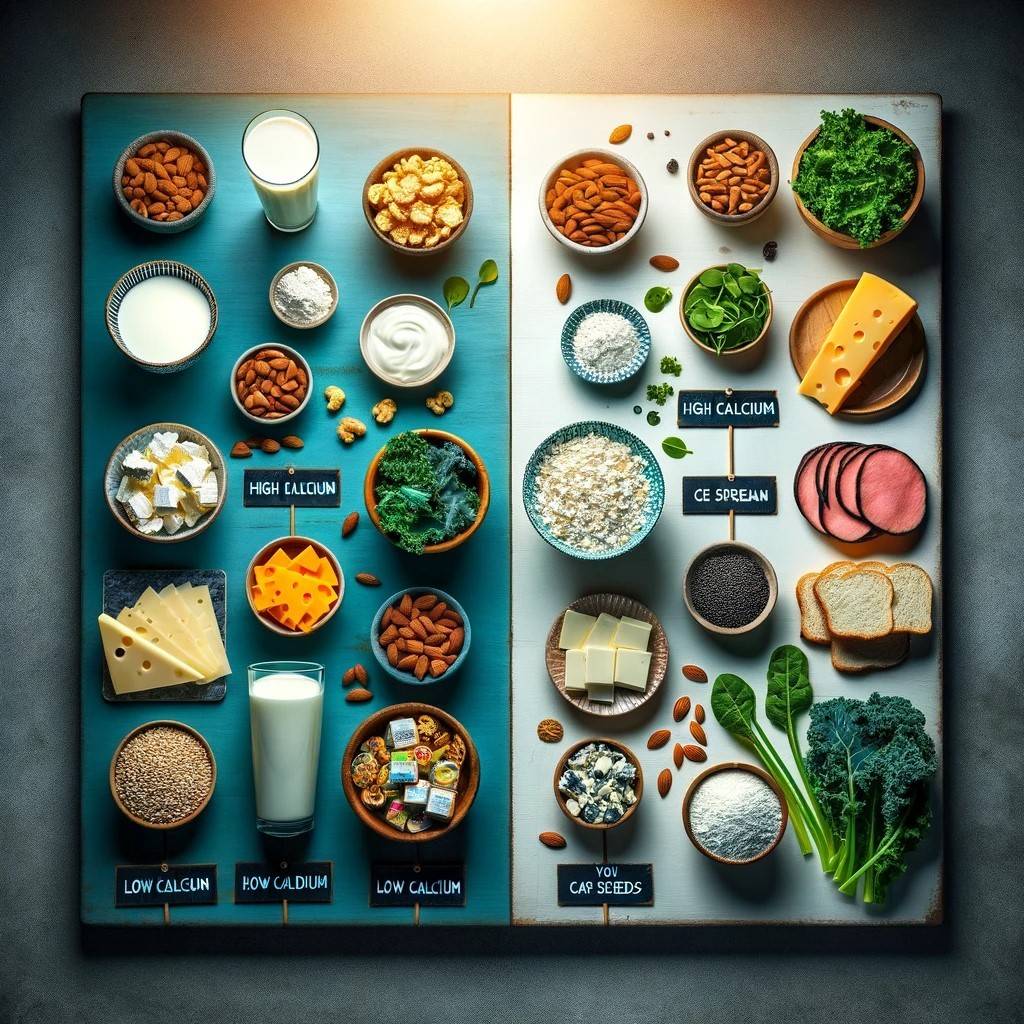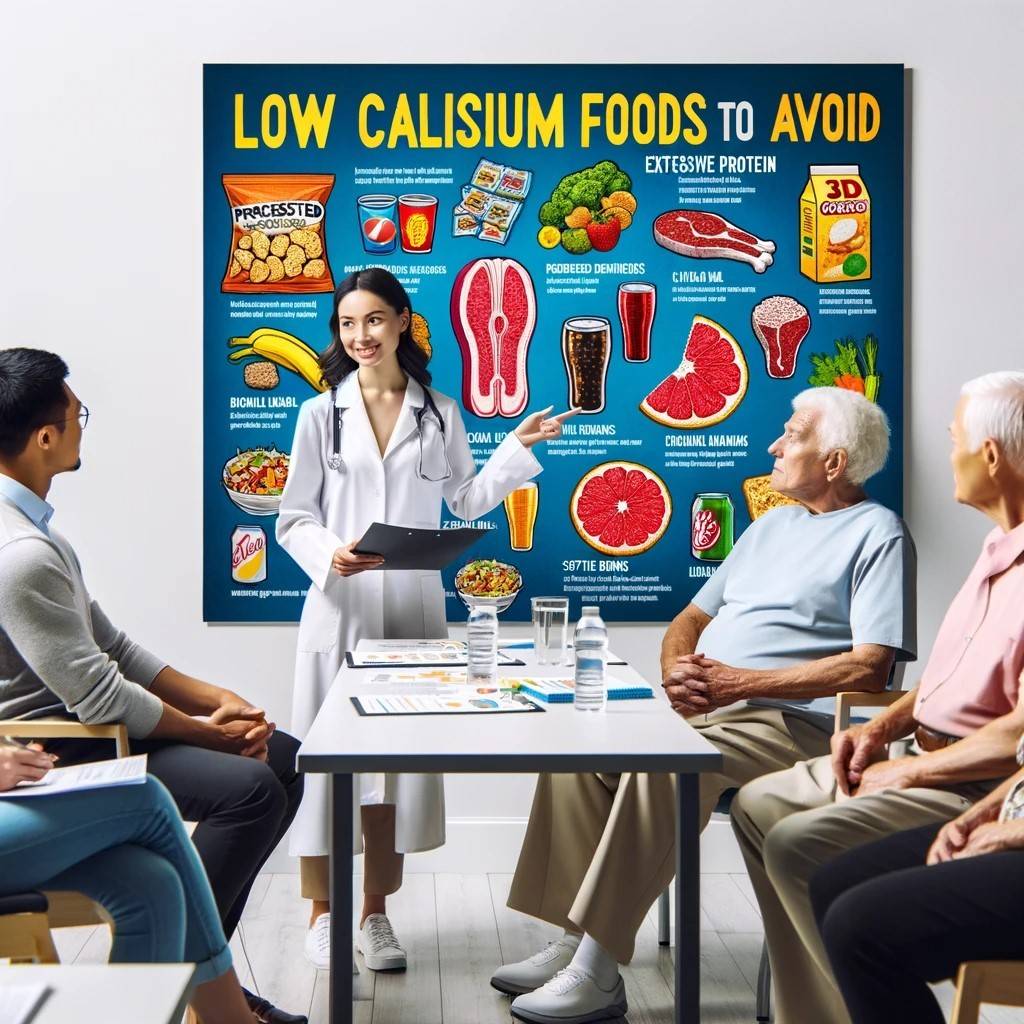Discover which low calcium foods to avoid for healthy bones. Learn how to protect your bone health. Don’t miss this essential guide.
Introduction
Welcome to our comprehensive guide, where we delve into the intricate world of calcium and its profound impact on our bones. Our journey will navigate through the lesser-known realm of low calcium foods, illuminating the paths to maintain and enhance bone vitality.
Understanding Calcium and Bone Health

The Vital Role of Calcium in Our Bodies
Calcium isn’t just a mineral; it’s a cornerstone for health, serving as the bedrock of our skeletal framework. Beyond providing structural strength, calcium plays a pivotal role in nerve transmission, muscle function, and heart health. It’s a versatile player in the physiology of our bodies, which underscores the necessity of adequate intake.
The Hidden Perils of Calcium Deficiency
Imagine a fortress slowly crumbling from within; that’s what bones endure when deprived of calcium. The stealthy thief of bone density, osteoporosis, creeps in, increasing the risk of fractures. The body, in its wisdom, will prioritize vital functions by leaching calcium from our bones, the reservoir of this mineral, which, over time, weakens their structure.
Calcium Needs: A Tailored Approach
The National Institutes of Health suggests that adults require about 1,000 mg of calcium per day, a number that increases for adolescents, postmenopausal women, and older adults. The key is to tailor calcium intake to one’s specific life stage to fortify bones for the journey of life.
Identifying Low Calcium Foods
When charting a course for healthy bones, knowing what to steer clear of can be just as crucial as knowing what to consume. Let’s uncover the foods that are low in calcium and why they might make their way into our diets.
The Culprits in Our Kitchen
Low calcium foods often lurk in plain sight within our pantries and refrigerators. These can include:
- Certain Plant-Based Milk: While plant-based milk is often fortified, some are not, offering minimal calcium content.
- Processed Meats: Deli slices and sausages are not only low in calcium but also high in sodium, which can impede calcium absorption.
- High-Sodium Snacks: Chips, pretzels, and crackers might satisfy a salty craving, but they’re hardly a source of calcium.
- Soft Drinks: Phosphoric acid in sodas can leach calcium from bones, and the caffeine can interfere with calcium absorption.
Understanding Food Labels
Deciphering food labels is akin to learning a new language. Look for the “% Daily Value” of calcium; a high percentage signifies a source of calcium, whereas a low percentage indicates the opposite.
Low Calcium Foods and Your Diet
Incorporating low calcium foods isn’t taboo; it’s about balance and moderation. Pair them with calcium-rich sides or follow them with a calcium-fortified beverage to keep your bone health on track.
Remember, it’s not about elimination but about strategic combination and balance in your diet.
The Consequences of Low Calcium Intake
Venturing into the realm of calcium consumption, it’s vital to acknowledge the repercussions of insufficient intake. Let’s explore the consequences that our bones might bear.
The Domino Effect on Bone Health
A deficit of calcium can lead to a cascade of bone health issues, such as
- Heightened Fracture Risk: Bones deprived of calcium may become brittle and more susceptible to breaks.
- Development of osteopenia and osteoporosis: These conditions represent stages of diminishing bone density and strength.
- Dental Dilemmas: Calcium also contributes to strong teeth. A scarcity can lead to dental decay and periodontal issues.
Beyond the Skeleton: Systemic Implications
The reach of calcium deficiency extends beyond bones, affecting:
- Cardiovascular Concerns: A correlation exists between low calcium intake and hypertension.
- Muscle Function: Calcium plays a role in muscle contractions, and its lack can lead to spasms or cramps.
- Mental Health: There’s emerging evidence linking calcium deficiency to mood disorders like depression and anxiety.
Navigating Nutritional Needs
Understanding the consequences is a powerful motivator for navigating our nutritional needs smartly. Incorporate calcium-rich foods like dairy products, leafy greens, and fortified foods into your diet to mitigate these risks.
Strategic Eating for Calcium Intake
Embarking on a strategic eating plan can ensure that your calcium intake is optimized. Here’s how you can navigate this.
Combining Foods for Maximum Absorption
Certain food combinations can enhance calcium absorption:
- Pairing Vitamin D with Calcium: Vitamin D-rich foods, like salmon or fortified eggs, aid in the absorption of calcium.
- Magnesium’s Role: Nuts and seeds, high in magnesium, are great partners for calcium absorption.
Foods to Favour
Here’s a list of calcium-rich allies to include in your diet:
- Dairy Delights: Milk, cheese, and yogurt are traditional calcium sources.
- Leafy Green Brigade: Kale, broccoli, and bok choy are not just trendy; they’re calcium-dense.
- Nutty Affair: Almonds and Brazil nuts offer a crunchy way to up your calcium intake.
When Supplements Make Sense
In certain circumstances, supplements can fill the gap:
- Dietary Restrictions: For those on vegan or lactose-intolerant diets, calcium supplements can be beneficial.
- Age Factor: As we age, our bodies demand more calcium; supplements can help meet this increased need.
Crafting a diet with calcium in mind doesn’t just support your bones; it builds the foundation for overall health.
Lifestyle Choices Affecting Calcium Absorption
It’s not just about what we eat but also about how we live. Lifestyle choices can significantly influence the body’s ability to absorb and utilize calcium.
Habits to Hold or Fold
- Smoking: The habit of smoking can decrease the efficiency of calcium absorption.
- Alcohol Consumption: Excessive alcohol can lead to bone density loss.
- Caffeine: High caffeine intake can interfere with calcium retention.
Exercise: A Bone-Boosting Activity
- Weight-Bearing Workouts: Activities like walking, running, or lifting weights can help bones retain calcium.
- Balance and Flexibility Routines: Yoga and Pilates can improve bone health and reduce the risk of falls.
Sunlight and Supplementation: Vitamin D’s Role
- Sun Exposure: Moderate sun exposure stimulates vitamin D production, which is critical for calcium absorption.
- Vitamin D Supplements: In regions with limited sunlight, supplements can help maintain adequate vitamin D levels.
Sleep’s Unsung Role in Calcium Absorption
- Regenerative Rest: Adequate sleep is associated with the body’s ability to repair and strengthen bones.
Adapting lifestyle choices to support calcium absorption is a testament to the adage that health is a lifestyle, not just a diet.
Integrating Low Calcium Foods into a Balanced Diet

While the focus is often on high-calcium foods, understanding where low calcium foods fit into our diet is crucial for balance.
Recognizing Low Calcium Foods
Identify foods that are typically low in calcium.
- Processed Grains: Foods like white bread and pastries have minimal calcium content.
- Some Vegetables: While most are beneficial, certain veggies, like spinach, contain oxalates that can inhibit calcium absorption.
- Certain Proteins: Meats and eggs are not as rich in calcium as other food groups.
Balancing Act: Not All Low Calcium Foods Are Villains
- Whole Foods Over Processed: Choose whole grains and natural foods, which, despite being low in calcium, offer other nutritional benefits.
- Phytic and Oxalic Acids: Be mindful of these compounds that can bind calcium and prevent its absorption.
Diet Diversity for Nutritional Equilibrium
- Colourful Plates: A colourful array of fruits and vegetables ensures a spectrum of nutrients.
- Protein-Packed Meals: Incorporate a variety of protein sources for a complete amino acid profile.
The Role of Meal Planning
- Calcium-rich breakfast: Start your day with a calcium-rich meal to kick-start absorption.
- Calcium Infusion in Snacks: Opt for snacks like yogurt or almonds to boost calcium intake throughout the day.
In the culinary orchestra of our daily diets, low calcium foods have their place, harmonizing with calcium-rich counterparts to compose a symphony of nutritional wellness.
The Critical Role of Calcium in the Human Body
Calcium does more than build bones; it’s a multitasker in the human body, playing several critical roles.
Calcium: Beyond Bone Structure
- Muscle Function: Calcium aids in the contraction and relaxation of muscles.
- Blood Clotting: It is essential in the cascade of events leading to blood clotting.
- Nerve Transmission: Calcium helps in transmitting nerve impulses throughout the body.
Understanding the Consequences of Low Calcium Intake
- Osteoporosis Risk: Insufficient calcium can lead to weakened bones and an increased risk of fractures.
- Dental Dilemmas: Teeth also suffer without adequate calcium, leading to dental issues.
- Hypocalcemia Symptoms: Low blood calcium levels can result in numbness, muscle cramps, and in severe cases, cardiac issues.
Recommended Daily Allowance (RDA) for Different Demographics
- Children and adolescents: Higher RDAs to support growth.
- Adults: Consistent intake to maintain bone health.
- Seniors: Increased need to counteract natural bone density loss.
Understanding the pivotal functions of calcium underscores the importance of monitoring intake, ensuring that the body’s diverse and dynamic needs are met.
Identifying and Managing Low Calcium Intake
Early detection and management of low calcium intake can prevent long-term health issues.
Identifying Signs of Low Calcium
- Physical Indicators: Watch for symptoms like brittle nails, dry skin, and fragile hair.
- Medical Signs: Frequent bone fractures or dental problems can be red flags.
Strategies to Manage Low Calcium Intake
- Dietary Adjustments: Introduce calcium-fortified foods and high-calcium alternatives.
- Supplementation: Consider calcium supplements, but first consult with a healthcare provider.
The Interplay of Vitamin D and Calcium Absorption
- Sun Exposure: Sunlight triggers the synthesis of Vitamin D, which aids calcium absorption.
- Dietary Sources of Vitamin D: Fatty fish and fortified foods can boost Vitamin D levels.
When to Seek Professional Advice
- Regular Check-Ups: Routine medical exams can help monitor calcium levels.
- Professional Guidance: Dietitians and nutritionists can provide personalized advice for calcium intake.
Proactive identification and management of calcium intake is essential, with a focus on incorporating a variety of sources and seeking professional input when necessary.
Dietary Choices and Their Impact on Calcium Levels
What we put on our plates significantly affects our calcium levels and, thus, our bone health and overall well-being.
High Calcium Foods vs. Low Calcium Foods: Making the Right Choices

- Incorporate Dairy: milk, cheese, and yogurt are high in calcium and should be a staple for those not lactose intolerant.
- Plant-Based Alternatives: For the lactose intolerant or vegans, fortified plant milks and leafy greens are excellent alternatives.
Understanding Food Labels
- Deciphering ‘Daily Value’ Percentages: Look for foods that provide at least 20% of the Daily Value (DV) of calcium per serving.
- Hidden Calcium Robbers: Some food additives and preservatives can inhibit calcium absorption.
The Impact of Cooking Methods on Calcium
- Preserving Calcium: Steaming vegetables instead of boiling can preserve their calcium content.
- Calcium Loss: High-temperature cooking can break down the calcium structure in foods.
Creating a Calcium-Friendly Kitchen
- Stock Up on High-Calcium Foods: Keep a ready supply of calcium-rich foods for meals and snacks.
- Innovative Recipes: Experiment with recipes that combine both high and low calcium foods for balance.
Making informed dietary choices is key to maintaining healthy calcium levels, which involves a blend of smart shopping, cooking, and eating habits.
Finally, let’s wrap up our discussion with practical steps to avoid low calcium foods and foster healthy bones.
Practical Steps to Avoid Low Calcium Foods for Healthy Bones
Steering clear of low calcium foods is a proactive step towards maintaining robust bone health.
Identifying Low Calcium Foods to Avoid

- Processed Foods: Often have reduced calcium content and should be consumed in moderation.
- Soft Drinks: Phosphates in sodas can leach calcium from bones.
- Excessive Protein: While necessary for health, too much can increase calcium loss.
Balancing the Diet for Optimal Calcium Intake
- Diversify Your Plate: Include a variety of calcium-rich foods in every meal.
- Moderation is Key: Balance calcium-poor foods with high-calcium counterparts.
Lifestyle Choices That Support Calcium Absorption
- Regular Exercise: Weight-bearing activities like walking and resistance training can strengthen bones.
- Limit Caffeine and Alcohol: Both can interfere with the body’s ability to absorb calcium.
Regular Screening and Monitoring
- Bone Density Tests: Recommended for at-risk populations to detect early signs of bone loss.
- Calcium Level Checks: Simple blood tests can monitor your calcium status.
By identifying foods low in calcium and making strategic lifestyle and dietary changes, individuals can significantly bolster their bone health and overall vitality.
FAQs about Low Calcium Foods
What foods lower calcium levels?
Foods that can lower calcium levels often contain certain components that interfere with calcium absorption. These include:
- Spinach and Rhubarb: While they contain calcium, they also have oxalates, which bind to calcium and can lower absorption.
- Sodas and Carbonated Beverages: The phosphorus in these drinks can lead to lower calcium levels.
- Excessive Salt: High salt intake can cause the body to excrete calcium through urine.
Remember, it’s all about balance. Eating these in moderation while maintaining a diet rich in calcium can help keep levels in check.
What foods should to avoid if they are high in calcium?
If you’re looking to avoid high-calcium foods, you might want to limit or avoid the following:
- Dairy Products: Such as milk, cheese, and yogurt, which are traditionally high in calcium.
- Canned Fish: Sardines and canned salmon (with bones) are high in calcium.
- Fortified Foods: Some cereals, juices, and plant milk have added calcium.
Which fruit is the lowest in calcium?
Most fruits are not major sources of calcium, but some have lower amounts than others. For instance:
- Apples: A medium apple has only 10 milligrams of calcium.
- Pears: A medium pear offers a mere 16 milligrams of calcium.
- Bananas: While known for potassium, bananas are low in calcium, with about 7 milligrams in a medium banana.
How can I eat less calcium?
To eat less calcium:
- Read Labels: Check for added calcium in processed foods and opt for those without added calcium.
- Choose Low-Calcium Alternatives: Instead of dairy, choose almond milk or rice milk without added calcium.
- Limit Seafood With Bones: Fish like sardines and salmon with bones are high in calcium.
- Focus on Low-Calcium Veggies and fruits: Emphasize fruits and vegetables that are naturally low in calcium.



